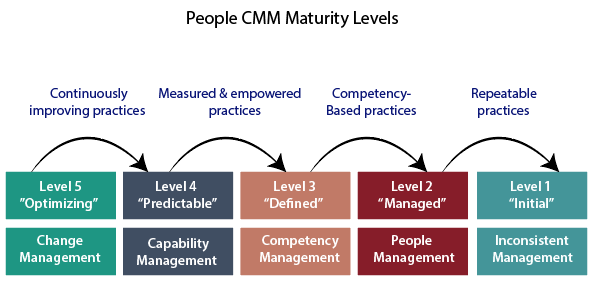People Capability Maturity Model (PCMM)PCMM is a maturity structure that focuses on continuously improving the management and development of the human assets of an organization. It defines an evolutionary improvement path from Adhoc, inconsistently performed practices, to a mature, disciplined, and continuously improving the development of the knowledge, skills, and motivation of the workforce that enhances strategic business performance. The People Capability Maturity Model (PCMM) is a framework that helps the organization successfully address their critical people issues. Based on the best current study in fields such as human resources, knowledge management, and organizational development, the PCMM guides organizations in improving their steps for managing and developing their workforces. The People CMM defines an evolutionary improvement path from Adhoc, inconsistently performed workforce practices, to a mature infrastructure of practices for continuously elevating workforce capability. The PCMM subsists of five maturity levels that lay successive foundations for continuously improving talent, developing effective methods, and successfully directing the people assets of the organization. Each maturity level is a well-defined evolutionary plateau that institutionalizes a level of capability for developing the talent within the organization The five steps of the People CMM framework are: 
Initial Level: Maturity Level 1The Initial Level of maturity includes no process areas. Although workforce practices implement in Maturity Level, 1 organization tend to be inconsistent or ritualistic, virtually all of these organizations perform processes that are defined in the Maturity Level 2 process areas. Managed Level: Maturity Level 2To achieve the Managed Level, Maturity Level 2, managers starts to perform necessary people management practices such as staffing, operating performance, and adjusting compensation as a repeatable management discipline. The organization establishes a culture focused at the unit level for ensuring that person can meet their work commitments. In achieving Maturity Level 2, the organization develops the capability to handle skills and performance at the unit level. The process areas at Maturity Level 2 are Staffing, Communication and Coordination, Work Environment, Performance Management, Training and Development, and Compensation. Defined Level: Maturity Level 3The fundamental objective of the defined level is to help an organization gain a competitive benefit from developing the different competencies that must be combined in its workforce to accomplish its business activities. These workforce competencies represent critical pillars supporting the strategic workforce competencies to current and future business objectives; the improved workforce practices for implemented at Maturity Level 3 become crucial enablers of business strategy. Predictable Level: Maturity Level 4At the Predictable Level, the organization handles and exploits the capability developed by its framework of workforce competencies. The organization is now able to handle its capacity and performance quantitatively. The organization can predict its capability for performing work because it can quantify the ability of its workforce and of the competency-based methods they use performing in their assignments. Optimizing Level: Maturity Level 5At the Optimizing Level, the integrated organization is focused on continual improvement. These improvements are made to the efficiency of individuals and workgroups, to the act of competency-based processes, and workforce practices and activities.
Next TopicSix Sigma
|
 For Videos Join Our Youtube Channel: Join Now
For Videos Join Our Youtube Channel: Join Now
Feedback
- Send your Feedback to [email protected]
Help Others, Please Share









